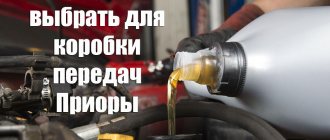Knowledge of automotive intricacies greatly helps in practice not only for those drivers who have little experience in operating a car, but also for experienced professionals. Among these important subtleties, undoubtedly, is the knowledge of what signs and how to distinguish transmission oil from motor oil.
Are there differences between motor oil and transmission fluid?
The answer to this question arises immediately. Of course there is a difference! Their very names speak eloquently about this. Motor oil and transmission fluid, which have essentially the same base, contain different ingredients.
However, it is definitely not worth checking the differences between these additives on the basis of your own car. Things can accidentally lead to a very serious breakdown, which then will have to be fixed for a long time and patiently. Experienced drivers know this well. So, if there is any confusion, the engine will immediately malfunction. The fact is that the transmission fluid in the engine, due to its components, will begin to burn out at a tremendous speed, and will immediately form all kinds of scale on literally all the surfaces it touches, and cleaning them later will be extremely problematic.
Therefore, careful car owners are very careful not to mix things up.
Oil recognition
They say that experienced auto mechanics can distinguish not only between a motor and a transmission by external signs, but also approximately name their brand. However, ordinary car enthusiasts do not have such knowledge. There are several signs you can look out for.
- Olfactory
. Transmission oil has a very specific smell. To some it smells like garlic, to others it smells like sulfur. However, you should not rely only on aroma. And the absence of a stink does not guarantee that this is motor oil: your runny nose or a poorly screwed cap on the bottle, which has released a significant part of the fumes, can be misleading; - Tactile
. Squeeze 2 fingers, dip into an unidentified oil and slowly spread. The film from the engine oil will stretch by 2-3 mm, and from the transmission oil it will break immediately. The method is also not very reliable: if you have not tried to do this before, it is quite difficult to truncate the moment of rupture and the distance; - Vodyanoy
. Considered to be the most vocal. A little water is poured into any container, and suspicious oil is dripped into it. If the drop immediately spreads across the water like a rainbow film, you are dealing with the transmission. If the lens dissolves reluctantly and floats for several minutes, almost without losing its shape, you have motor oil in the bottle.
Read also: Mad max secret machines
An even less reliable sign is peeling and blurring of labels. It is believed that this is the effect of exclusively transmission oil. Although, logically speaking, pieces of paper can come off due to humidity, and letters can become blurred due to the ingress of other liquids. So, if the bottle is practically empty, and you are not very pressed for money, it is better not to guess how to distinguish engine oil from transmission oil, not to experiment, but to buy new one. Repairs, flushing and complete replacement will in any case cost more.
How to distinguish engine oil from transmission oil? A few simple details
It is clear that there are certain nuances and characteristic features for each species. And in general, what are the dangers of such an operation if a misunderstanding does occur? In this case, professionals recommend draining the oil completely, cleaning the engine with a special flush and refilling with fresh oil specifically intended for the engine. And do it as quickly as possible!
How to distinguish engine oil from transmission oil?
There are several folk methods and signs that can always be used to determine the difference if the label is torn off. But let’s first figure out why flooding with the wrong composition is dangerous for a car. And what actions should be taken if there is confusion.
In theory, the base of both types of oil is the same. They differ in additives designed to adapt the base to perform clearly defined tasks. And these additives are almost always not friendly with each other.
Possible consequences:
Gear oil is not intended for use at high temperatures. In the engine they go off scale. Accordingly, the transmission poured into it will burn out at an unimaginable speed, forming stuck layers on everything it touches.
If the operation does not last long, then a disaster most likely will not happen. But if you give up, you can get to the capital. Experienced car owners know that even motor oils of different compositions cannot be mixed (for example, mineral water and synthetics are certainly not recommended). And here are liquids for different purposes.
The consequences of their interaction are impossible to predict. The simplest option is foaming the oil. However, the formation of clots or sediments, or even thickening of the oil to a paste-like state, is no less likely. How lucky you personally will be is a matter of individual luck.
If the situation is the opposite (), then in addition to the possible reaction of additives with each other, difficult operation of the transmission will be observed. Motor oil is more viscous, although this cannot be determined visually.
At the same time, experienced drivers admit that in the most extreme cases it is still possible to fill the engine with a transmission. However, only until you reach your base. And in order to avoid various complications, the oil must be changed completely after this, and even with additional flushing of the engine.
They say that experienced auto mechanics can distinguish not only between a motor and a transmission by external signs, but also approximately name their brand. However, ordinary car enthusiasts do not have such knowledge. There are several signs you can look out for.
- Olfactory
. Transmission oil has a very specific smell. To some it smells like garlic, to others it smells like sulfur. However, you should not rely only on aroma. And the absence of a stink does not guarantee that this is motor oil: your runny nose or a poorly screwed cap on the bottle, which has released a significant part of the fumes, can be misleading;
- Tactile
. Squeeze 2 fingers, dip into an unidentified oil and slowly spread. The film from the engine oil will stretch by 2-3 mm, and from the transmission oil it will break immediately. The method is also not very reliable: if you have not tried to do this before, it is quite difficult to truncate the moment of rupture and the distance;
- Vodyanoy
. Considered to be the most vocal. A little water is poured into any container, and suspicious oil is dripped into it. If the drop immediately spreads across the water like a rainbow film, you are dealing with the transmission. If the lens dissolves reluctantly and floats for several minutes, almost without losing its shape, you have motor oil in the bottle.
Read also: Fog lights Skoda Rapid 2018
Knowledge of automotive intricacies greatly helps in practice not only for those drivers who have little experience in operating a car, but also for experienced professionals. Among these important subtleties, undoubtedly, is the knowledge of what signs and how to distinguish transmission oil from motor oil.
Distinctive features of motor oil
To know how to distinguish motor oil, you need to start from its main functional purpose - to lubricate the power unit and its working components. Such an emulsion should maximally and effectively soften the design of the motor, those of its components that are constantly in contact during engine operation. It is made on the basis of either synthetic components or mineral ones, but it can have a mixed composition, forming so-called semi-synthetic liquids. This is done to ensure that the engine oil has the ability to reliably lubricate parts at elevated temperatures and pressures.
Unlike transmission fluid, motor oil has a higher viscosity, although only very experienced auto mechanics and drivers can visually determine this. There are also differences in color, which can only be determined by professionals.
Car engine oil
The liquid used to lubricate the elements of internal combustion engines (in the areas of the cylinder combustion chamber, the cylinder-piston interface and the crankcase) is called motor oil.
It is a mixture of base oil (up to 85%) and additives necessary to impart certain properties to the product. These additives have different effects:
- antioxidant;
- detergent;
- anti-corrosion;
- anti-wear;
- dispersant, etc.
Typically, ready-made additive complexes are used. It is important that there is no antagonistic effect between different components.
Classification by composition
Depending on the base of the lubricant (method of its production and composition), the oil can be mineral, synthetic or semi-synthetic.
Mineral
It is a product of the distillation of crude oil, purified from harmful inclusions, resulting in increased chemical stability and resistance to corrosion processes. It is quite cheap, but its functional characteristics can only be considered satisfactory.
Synthetic
To obtain a synthetic lubricating fluid, the synthesis of organic compounds (PAO (polyalphaolefins), glycols, esters, etc.) is used. Synthetic oil is also produced from petroleum products (there is technology for producing lubricant even from natural gas), but using deeper processing.
Synthetics are characterized by much higher stability, better temperature-viscosity parameters and a longer service life. However, the price of such a product is appropriate.
Semi-synthetic
Semi-synthetics are made from a mixture of mineral base oil with the addition of synthetic components. At the same time, the content of the mineral component in it reaches 70...80%. This lubricant has a number of advantages compared to mineral water. It costs less than its synthetic counterpart.
Classification by viscosity and seasonality
One of the most important characteristics of motor oil is its viscosity and temperature dependence. To describe the compliance of the temperature-viscosity parameters of the lubricant with the engine requirements, the international SAE classification is used. Oil classes according to it are presented in the photo.
In accordance with this standard, motor oil is divided into three categories: summer, winter and all-season. Today, the greatest demand among vehicle owners is an all-season product, the use of which allows the vehicle to be used year-round.
To separate liquids according to their operational properties, the API classification is used.
The European Automobile Manufacturers Association has developed the ASEA classification. According to it, motor oil is divided into three categories:
- A/B - lubricant for gasoline/diesel power units of passenger cars.
- C is an environmentally friendly oil for gasoline and diesel engines, which can be used with a catalyst and particulate filter.
- E - oil for heavy trucks.
Transmission fluid differences
The main task of the transmission fluid is to create a more durable oil film on the parts of this design. This requirement determines the key difference between gear oil. It is explained by the fact that the parts of the transmission rub with much greater force and receive a much greater mechanical load than in the engine, and if they are not lubricated abundantly, they wear out very quickly and fail. The composition of such a liquid is created taking into account the fact that it will have to work at a more gentle temperature regime than engine oil. Moreover, this mode is, as a rule, stable in nature, without sudden changes, as is recorded in a car engine.
What is a mistake worth?
Getting engine oil into the transmission is undesirable, but not critical. The properties of the lubricant will change, and the overall functioning of the unit may deteriorate. But this will still lead to fewer problems than pouring transmission oil into the crankcase.
Even a small amount of transmission fluid can disrupt the operation of the unit. This oil cannot operate at elevated temperatures and burns quickly. As a result, carbon deposits form on the internal surfaces of the engine and the oil turns into flakes, which can lead to major repairs.
How to determine the type of motor oil
Experts can determine the difference between engine oil and transmission oil in several effective ways. Naturally, the most reliable way is to test them one by one in a laboratory using special equipment and sensors. It is clear that in practice this is a very inconvenient and sometimes simply unrealistic option. Indeed, you shouldn’t carry equipment with you specifically to use it, for example, while traveling, far from service stations or your home garage.
It is much easier and faster to do this by using traditional methods and distinguishing them visually, by color, smell and viscosity, as well as using ordinary water.
By smell
It should be noted that this widespread, fairly effective method of verification still does not provide a 100% guarantee. It is available only to those drivers or auto mechanics who have been faced with similar issues in their line of work for several years now. In addition, you must also have an excellent sense of smell. Such experts claim that the smell of gear lubricant has a specific shade, like a garlicky or sulfurous aroma.
However, their diagnosis will be accurate only if the liquid they tested was previously stored in a tightly closed container and could not ventilate. If she had access to open air, the specific shade has probably already evaporated and it is extremely difficult to determine from the smell alone what purpose such a liquid is intended for. Since the cost of an error is very high, experts strongly recommend not to take risks and try other forms of verification.
Let's sum it up
High-quality oil, used as intended, guarantees the correct and uninterrupted operation of the functioning components of the machine. If a situation arises when there is a need to determine the type of oil available without identification marks, you can use simple methods, which consist of checking by smell, appearance or water testing, however, you should not trust such methods one hundred percent. The true composition of the oil can only be reliably confirmed by laboratory analysis, which is highly expensive. If, after checking the lubricant, there are still doubts about its type, it is better to refuse to use such products, throw away the remains, and buy a new motor oil. Believe me, new lubricant, regardless of whether it is intended for the engine or transmission, will cost much less than a major overhaul of the car.
What happens if you mix up the oils?
If you mix up the oils, the car may fail. For example, if transmission fluid is mistakenly poured into the engine, the power unit is very likely to fail altogether.
The bottom line is that such a liquid, entering a new and unfavorable environment for it with a high, harsh temperature regime, will burn out after a short time and turn into sludge, deposited inside the engine walls as scale. If, on the contrary, you pour motor lubricant into the gearbox, the consequences will not be so depressing.
Experts do not recommend experimenting with such things, since it is unacceptable to risk the “health” of a car, as well as a person. Ultimately, his treatment will be expensive, if it will help at all.
What is oil used for?
Modern vehicles use several types of oil. It is divided according to purpose:
- motor - used in internal combustion engines;
- transmission - necessary for the operation of the gearbox;
- hydraulic - designed for mechanisms operating under high pressure (used in power steering);
- flushing - used to flush the power unit from residual waste lubricant.
Lubricants used in cars are necessary to reduce energy losses due to friction (they can “eat up” up to a quarter of the power developed by the engine) and reduce wear of rubbing structural elements. Oil protects parts from corrosion, cleans and cools surfaces.
Main functions of automotive lubricants:
- preventing dry friction of parts by creating an oily film on the surface;
- heat removal from rubbing units;
- prevention of corrosion phenomena;
- removal of wear products.
At the same time, the oil is required to be compatible with seal materials, low volatility, resistance to external influences, and also maximum environmental friendliness. It must maintain stable characteristics for a long time. Some types of lubricants have additional requirements.
Important! All tolerances for lubricating fluid that can be poured into a car engine or transmission are usually indicated in the technical documentation for it.
Any vehicles have their own design features and are operated in different conditions, so different requirements are placed on consumables.
Many car enthusiasts do not see the difference between a motor and transmission product. However, they exist, and they are significant ones at that.










